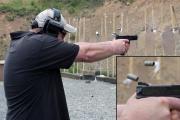It seems that over the last 12-18 months or so, the quality control practices in the gun industry have fallen flat, become secondplace to marketing the newest "big" thing and so on. Some examples:
-Generation 4 9mm Glocks.
-M&P front sights
-SIG's untouchable reputation for quality is now "hit and miss"
The industry as a whole seems to be sliding towards mediocre quality products. Why? Is it the growth that the firearms industry is experiencing, particularly the self defense pistol industry, to much to handle at once, and it keeps quality products from being made quickly enough to meet demand? Are serious end users so few and far between that questionable quality is fine for most of the consumer base? Have we as the customer for some reason made it ok to send a gun back to a manufacturer 1,2,3 or more times?
What gives? Is there a solution?
How can the same make and model of gun go from impeccably reliable, and perfectly crafted; to having parts fall off- in just six years of production. (M&P)
The benchmark of reliability is now an exercise in parts fiddling a la 1911. (Glock)
The only good ones are German made? Really? (SIG)
This is killing me.




 Reply With Quote
Reply With Quote






